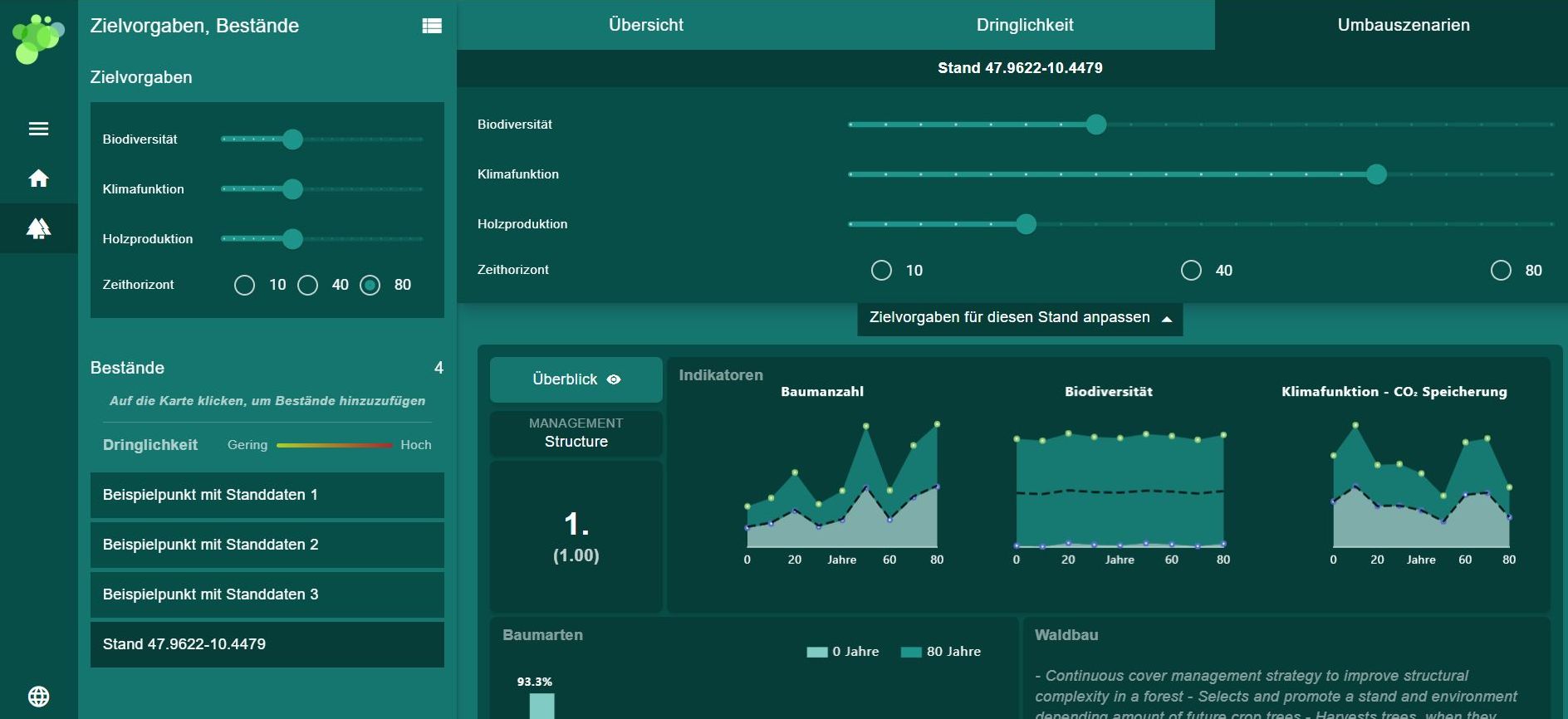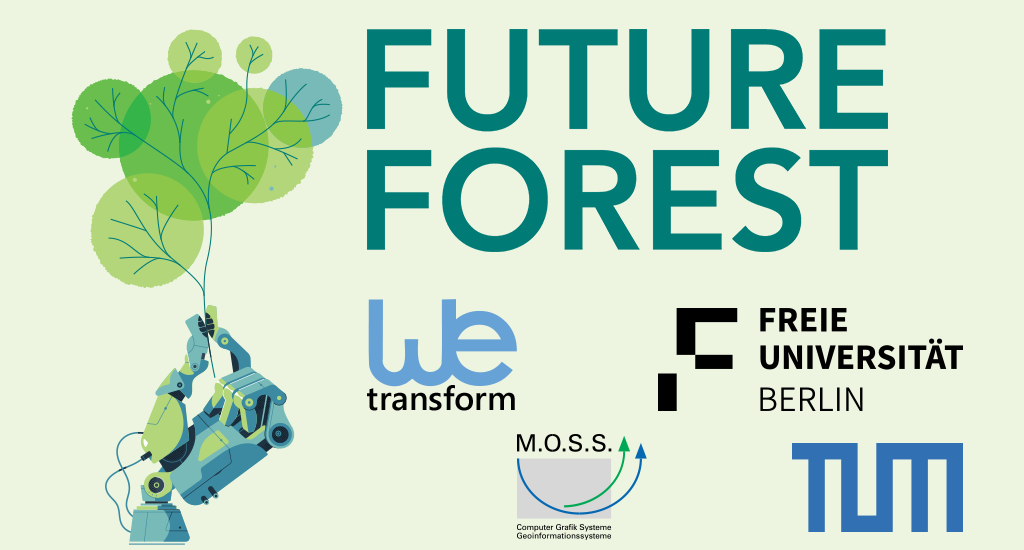
Flagship Project FutureForest: AI Support for Climate-Resilient Forestry
The effects of climate change create great challenges for our forests. Droughts, fires, storms, and pests are all on the rise, and existing forestry know-how is often no longer enough to set our woods up for a secure and climate-resilient future. This is where the FutureForest project comes in. Through the use of Artificial Intelligence (AI) combined with the establishment of a data space, and sophisticated simulation methods, FutureForest brings significant improvements to forest condition analysis, the assessment of future forest developments, and decision-making for climate-adapted forest conversion.
After three years, the project, funded by the German Federal Ministry for the Environment, Climate Action, Nature Conservation and Nuclear Safety (BMUKN), has achieved its key objectives and delivered practice-relevant results to pave the way towards a more sustainable and climate-resilient forestry sector.

The Path to a Climate-Resilient Forest
It is important to start by asking the right questions:
- Which forest stands need to be prioritised during conversion?
- Which tree species will be most suitable to withstand future climate conditions in a given location?
- How can forest conversion be managed while accounting for biodiversity, economic efficiency, and climate protection?
In order to answer these questions, we support forest conversion in a data-driven and practice-relevant manner. Our approach included the development of satellite-based methods to document existing tree species and their condition, as well as the installation of sensor fields in various locations. In addition, we used AI models to simulate forest development under different climate scenarios.
As emphasised by Prof. Dr. Fabian Faßnacht of the Freie Universität Berlin, comprehensive and accurate location mapping is of vital importance. To have such data available, we developed AI and transformer methods for the nationwide determination of tree species and their condition, based on satellite imagery over time. In order to provide early detection of damaging events, we had to overcome technical hurdles such as the high computing power required for comprehensive model calculations and the limited resolution of Sentinel-2 data.
A data-driven approach needs to be built upon a high-performance data infrastructure. To provide this foundation, the FutureForest project centred on the creation of the Forest Data Space (FDS), a decentralised and transparent data ecosystem. The FDS provides access to a wide range of data sets, ranging from climate scenarios to tree species distribution and vitality maps, and solves existing issues:
- Data holders will no longer have to relinquish data sovereignty
- Digital solutions and data-driven forest decision-making within Germany will no longer be hampered by limited, fragmented, and difficult-to-reuse forestry data
The FF.ai Decision Support System (DSS) was created as a practical tool to provide location-specific, data-based recommendations for climate-adapted forest conversion. It supports decision-makers in forestry, administration, and politics.

The FutureForest project’s focus areas also included the establishment of an interdisciplinary network of experts to disseminate knowledge, share experience, and facilitate the implementation of innovations in both practice and policy.
FutureForest’s Key Results
Nationwide assessment of tree species and condition
New comprehensive and accurate methods have been developed to determine tree species and their condition based on satellite imaging over time. We managed to achieve 77% accuracy in our testing area in Baden-Württemberg, which is a 7% improvement on the existing state-of-the-art technology, while accounting for two additional tree species. The methodological approaches, datasets, trained models and code developed are all publicly available, such as the tree species map of Germany and the iLand model of forest landscape dynamics.
Additionally, a multi-stream network was implemented to integrate high-resolution aerial photography and improve the classification of spruce and fir trees in mixed stands. This approach increases species-specific accuracy by about 8% compared to the base model.
Early detection of forest disturbances
FutureForest also included the development of a transformer model for the early detection of forest disturbances, such as bark beetle infestations. The model processes Sentinel-2 timelines and can detect issues with great accuracy (9% omission error, 3% commission error) and can be used at the sub-pixel level. In the case of bark beetle infestations, a near real-time monitoring system has been developed that after 13 weeks achieved 85% user accuracy (User Accuracy in combination with remote sensing and image classification) and 82% producer accuracy. You can find the weekly updated Sentinel-2-based forest disturbance predictions here.
AI-based simulation models
Models were created that enable projections of forest development in Germany under various climate scenarios (Ref. iLand, SVD). Based on data from the Federal Forest Inventory (BWI) and remote sensing, as well as a division of Germany into 12 landscapes, over 11,500 simulations were carried out, generating more than 8 TB of data. This includes indicators for wood (growth, stock), climate function (carbon storage) and biodiversity (species distribution, amounts).
FutureForest Decision Support System (DSS)
We created a prototype of the FutureForest DSS. It provides location-specific, data-based options for climate-adapted forest conversion. In order to rank the available options, the ProMCDA (probabilistic multi-criteria decision analysis) method was developed and made available as open source. The software’s recommendations are intended to help forestry practitioners expand their empirical knowledge with insights from data analysis and thereby develop objective solutions.
Forest Data Space (FDS)
This open, decentralised data infrastructure has been created to enable participants to access a wide range of data sets and make their own sensitive data available for use by others. In doing so, the data remains with the data owners, who retain full sovereignty and control over the use of their data at all times. The Forest Data Space is intended to make a significant contribution to overcoming structural issues that would hamper a functioning data economy. Further information can be found on the FDS website.
Installation of sensor networks
Sensor networks were installed at two test sites in Landshut and Brandenburg. In these locations, dendrometers, sensors for monitoring soil temperature and moisture profiles, and wildlife cameras were installed. The measured data was collated and published via a web interface and was also used to derive any correlations between measured and remote sensing data.
Competence network and dissemination activities
Activities surrounding capacity building and dissemination were focused on knowledge transfer and networking within the forestry community. This included establishing and maintaining a network of experts, as well as a series of workshops and webinars on the FF.ai DSS and Forest Data Space. The highlight was the SmartForest 2025 conference (13–14 March 2025, TU Munich), which brought together over 150 participants from multiple countries to discuss their challenges and solutions for climate-resilient forestry.

Where We Are Now and What Needs to be Done
FutureForest has made key contributions to the digitalisation and climate adaptation of the German forestry sector. It has shown how remote sensing, artificial intelligence, and data-based decision support can help establish forests fit for the future. By developing more accurate methods for the detection of tree species and forest health monitoring, AI-based simulation models, a comprehensive decision support system, and a forest data space, FutureForest has created tools that actively support climate-adapted forestry within Germany. The project’s efforts in capacity building, networking, and data infrastructure also ensure that the solutions can be implemented across practice, politics, and research.
While FutureForest has laid crucial foundations for climate-resilient forestry, the road ahead remains complex and it will require further effort in order to build upon these foundations. The methods and tools developed need to be thoroughly validated by experts and practitioners. A significant improvement to the data base and access to that data, along with the establishment of a data economy based on common standards, will be essential to effectively train and apply AI models. In addition, considerable efforts are needed to put the findings and proposals into practice and to gain stakeholder acceptance. Last, but not least, economic conditions and incentives must be implemented to ensure that sustainable and future-proof forestry has a real chance.

Conclusion and Outlook
The FutureForest project has demonstrated how the use of AI and modern data management solutions can advance the German forestry sector. By developing more precise methods for tree species recognition and forest health monitoring, innovative simulation models, and a comprehensive decision support system, FutureForest has provided concrete tools and recommendations for climate-adapted forest conversion.
The newly created Forest Data Space and the extensive measures taken to enable the exchange of knowledge and establish a data ecosystem help put these innovations into practice. While challenges such as data availability continue to exist, we believe that FutureForest was truly a flagship project that has made a decisive contribution to preserve and maintain our forests for future generations. Continuous development of our models and a close collaboration between researchers and practitioners will be crucial in making German and European forests more resilient to the effects of climate change.
What Happens Next: SAGE and InGeoDTM
We will continue this success story with two further research projects.
In the project InGeoDTM, we are developing a data trustee for geo-data spaces. The main challenges here are the development and utilisation of legally compliant governance models on the one hand and, on the other, the development and validation of sustainable business models for data trustees without compromising their credibility and independence. You can learn more about InGeoDTM here.
SAGE is a multinational project with over 40 partners, funded by the European Union. It aims to establish and operate the Green Deal Data Space (GDDS). In this project, we are tasked with contributions to the implementation of the technical infrastructure and governance, embedding the Forestry Data Space (FDS) in the GDDS as one of ten use cases, and developing and validating sustainable business models.

The FutureForest Project Partners
wetransform GmbH: Project coordination, conceptualisation and development of the forest data space and decision support system, as well as capacity building and dissemination.
Freie Universität Berlin: Development of new AI-based methods for tree species and condition recognition using remote sensing data, as well as implementation of sensor systems for measuring climate-relevant data in real time.
Technische Universität München: Modelling future forest development and forest conversion scenarios.
M.O.S.S. Computergrafik Systeme GmbH: Development of the forest data space.



